One of the sweetest varieties is "Rocket" beet: description, advantages and disadvantages
Beets are a vegetable that can be found in almost every garden bed. The culture is rich in iron, iodine, potassium, magnesium, zinc, copper, vitamins of group B, P. It has a beneficial effect on the cardiovascular and nervous systems, has an antioxidant effect.
Of all types of beets, hybrids bred abroad, mainly in France or Holland, are of particular interest. Rocket f1 is their bright representative.
The content of the article
Description of beets
Some gardeners happily plant hybrids and recommend them to others, others prefer varieties. In each case, there are pros and cons - let's find out what they are for Rocket.
F1 hybrid
F1 are first generation hybrids: they are obtained by crossing two varieties. They take the best from their "parents": for example disease resistance, cold resistance or high yields.
Important! The seeds from such fruits are no longer used for planting: they lose most of their unique properties, that is, the quality of future fruits will be low.
In the photo beets Rocket F1
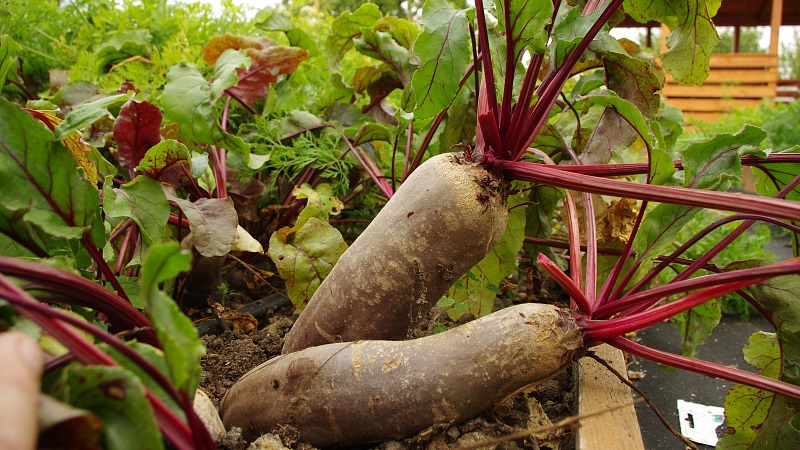
Origin and development
The first Rocket f1 seeds came to Russia from Holland in 1998... Due to its sweetness, good keeping quality and ease of growing, beets quickly gained a place in the Russian market and in the gardens of summer residents throughout the country.
Distinctive features
The hybrid is recommended for cultivation in Northwest, Central and East Siberian regions.
Rocket - beetroot with cylindrical roots. It is distinguished by tender and juicy pulp of bright uniform color without rings. Vegetables are cooked quickly without losing their taste and useful properties.
Characteristic
Leaves of medium shape, elongated, dark green, with wavy edges, arranged vertically on long red stems. Seeds are multi-germ: even from a small amount of planting material, a densely populated bed is obtained.
The average weight of one root crop is 200-300 g... The pulp is sweet (sugar content - 11.7%). Rocket is a mid-season hybrid: 90–120 days pass from germination to biological maturity. The yield is high (5-7 kg / m2), vegetables are stored for a long time.
It can be useful:
How to grow
Beets are grown in two ways: direct sowing into the ground or through seedlings. The second method helps to obtain an early harvest, helps to avoid unnecessary losses if there are very few seeds. The lack of seedlings is a violation of the root system when picking (it takes about two weeks to recover).
Planting with seeds
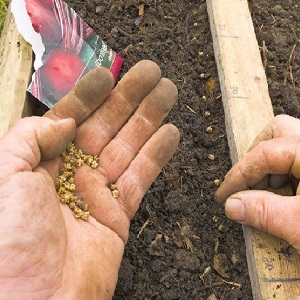 The seeds of the hybrids that are purchased in stores have already been processed by the manufacturer and are ready for planting.
The seeds of the hybrids that are purchased in stores have already been processed by the manufacturer and are ready for planting.
The garden bed has been prepared since autumn, from October to November.... Beets love sunlight and fertile soil of neutral acidity. To do this, organic fertilizers are introduced into the ground: compost or rotted manure (3 kg / m2), mineral compositions: 25 g of ammonium sulfate, 35 g of superphosphate and 15 g of potassium chloride per 1 m32.
When sowing in the winter, 4 liters of organic fertilizers and 30 g of potassium chloride with 30 g of superphosphate are applied. In spring, add 30 g of urea per 1 m2 sown area.
Too acidic soil increases the risk of root rot... To reduce acidity, lime is added to the soil in a ratio of 550-1000 g per 1 m2... Depending on the level of acidity, a solution of 1 tbsp is used. lime per 10 liters of water.
3-5 days before planting, the bed is dug up, weeds and wood ash are removed from it. Pre-soaked seeds are planted in moist soil to a depth of 2-3 cm, at a distance of 25-30 cm from each other. Sprinkle with loose earth on top.
Sowing beds in late April and early Maywhen the ground has already warmed up to + 10 ° C.
Seedling method
Soil for seedlings is taken fertile and neutral in acidity... The ideal ratio is 75% peat, 20% turf and 5% sand. Not later than an hour before sowing, the mixture is watered with a 1% solution of potassium permanganate.
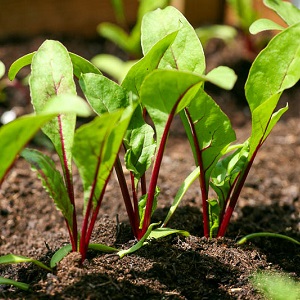 The soil is poured into boxes 8-10 cm from the bottom, leaving 3-4 cm to the top, moistened with warm water (+ 15… + 20 ° C). At a distance of 10 cm, grooves are made with a depth of 2-3 cm. Between the seeds themselves, 7-8 cm are kept. From above, the planting material is sprinkled with earth and well compacted.
The soil is poured into boxes 8-10 cm from the bottom, leaving 3-4 cm to the top, moistened with warm water (+ 15… + 20 ° C). At a distance of 10 cm, grooves are made with a depth of 2-3 cm. Between the seeds themselves, 7-8 cm are kept. From above, the planting material is sprinkled with earth and well compacted.
Already the first shoots appear in a week... They are thinned out at the stage of 3-4 leaves: each sprout is carefully removed with a teaspoon and, together with the earth, transplanted into another planting box. The operation is repeated once more when the number of leaves on the seedlings becomes more than six.
Beets love water, because the soil is always moistened... Watering is carried out with settled water as the top layer of the soil dries up, and the excess water drained into the pan is poured out. Every 3-4 days, they gently loosen the ground.
Every two weeks, seedlings are fed organic and mineral fertilizers in a ratio of 3: 1.
From organic use:
- bird droppings solution (1:12);
- slurry (40-50 g / m2).
The last feeding produced 10 days before planting in the ground.
Important! Nitrogen fertilizers are contraindicated for seedlings: they will lead to the death of all seedlings.
Care
Beet grows well in the neighborhood of potatoes, onions and cucumbers or in the soil after them.
When planting by seedswhen the first 3-4 leaves appear, the sprouts are thinned out. Do this in the same way as when growing seedlings. A distance of 10-12 cm is left between the plants.
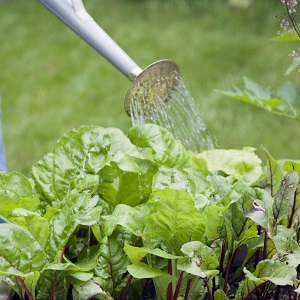 Water the crop depending on weather conditions, but so that the bed is always wet. On average, 5-6 waterings are carried out throughout the entire ripening. The next day after irrigation, the soil is weeded to a depth of 3-5 cm.
Water the crop depending on weather conditions, but so that the bed is always wet. On average, 5-6 waterings are carried out throughout the entire ripening. The next day after irrigation, the soil is weeded to a depth of 3-5 cm.
For fast and lush growth beets are fertilized with calcium, sodium, mineral and organic compounds.
The first feeding is done after first thinning, add urea, about 10 g / m2... For the first time, only 25% of the norm is used, the remaining amount is applied every three weeks throughout the season.
The second time the culture is fertilized after closing the tops in the aisles:
- 8 g of superphosphate and 10 g of potassium chloride per 1 m²;
- ready-made mineral fertilizer containing chlorine compounds.
A good help in pest control - watering beets with brine (1 tbsp. In a bucket of water) in the middle of summer.
Read also:
Growing features
Rocket - cylindrical beets, grows mainly vertically down and up, which significantly saves space on the beds.
The hybrid is resistant to frost, but it can still freeze slightly, and to flowering, so the fruits will always be of excellent quality.
Diseases and pests
Rocket resistant to major diseases of culture... In order not to destroy the fruits, avoid over-wetting the soil and do not overload the soil with chemicals.
The hybrid is not immune from insect pests. Particularly dangerous for beet beds are:
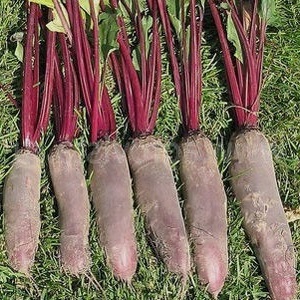 miner fly - lays eggs on the underside of the leaves, and the hatched larvae gnaw the leaves from the inside;
miner fly - lays eggs on the underside of the leaves, and the hatched larvae gnaw the leaves from the inside;- scutellus - small beetles, similar to bedbugs, gnaw holes in plants, which can cause root crops to die;
- beet flea - small greenish bugs that eat holes in the leaves;
- wireworm - its larvae destroy the seeds and roots of already sprouted fruits;
- beet aphid - feeds on plant juices, which is why the root crops grow small.
To combat them, the beds are dug up, weeds are removed, and the leaves of the tops are treated with special insecticides.
Harvesting and application of the crop
Harvest harvested before frost, approximately 100–125 days after planting. The fruits are pulled out of the ground without damaging the skin, and the tops are cut with a knife.
Beetroot Rocket well tolerates transportation, long storage at a temperature of 0… + 3 ° C in boxes or basements.
It's a versatile hybrid: suitable for consumption both raw (for example, in salads) and boiled. Useful vegetable juices are prepared from sugary root crops; thanks to the rich color, beets are added to borscht, winter preparations.
Advantages and disadvantages
Rocket f1 advantages:
- pulp without rings, sweet fruit taste;
- resistance to flowering, drought and major diseases;
- high yield, excellent fruit quality;
- easily transported over long distances, stored for a long time.
Only flaw, inherent in all first-generation hybrids - the seeds that sprouted vegetables give cannot be used the next year.
Farmers reviews
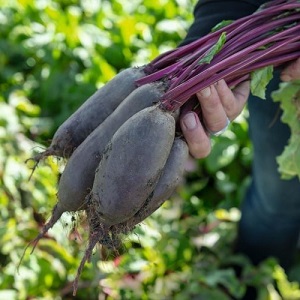 On many Internet forums, where they discuss which beets to choose for planting, they mention the Rocket hybrid. It is often advised for growing.
On many Internet forums, where they discuss which beets to choose for planting, they mention the Rocket hybrid. It is often advised for growing.
Love, Oryol: “Unmatched beets, I have been planting for the third year in a row, I will not trade them for any. Dark-burgundy pulp without rings, cooks quickly, excellent taste ".
Tatiana, Novosibirsk: “Last year the seed saleswoman persuaded to try Rocket F1, production - Holland, packing - Gavrish. Great beets! The size of the roots is average, there are no rings, sweet and dark flesh. The crop is stored for a long time, does not deteriorate ".
Conclusion
Rocket f1 is a favorite of many summer residents. Due to their cylindrical shape, the roots are compact and fit in any garden bed. Caring for the crop does not require unnecessary trouble: it is relatively resistant to frost, has a strong immunity to major diseases.
Rocket is suitable for long-term storage: vegetables wrapped in plastic and put in a dark dry box will remain there for another six months without losing quality and taste. When planting this hybrid in the garden, you can always count on a rich harvest.